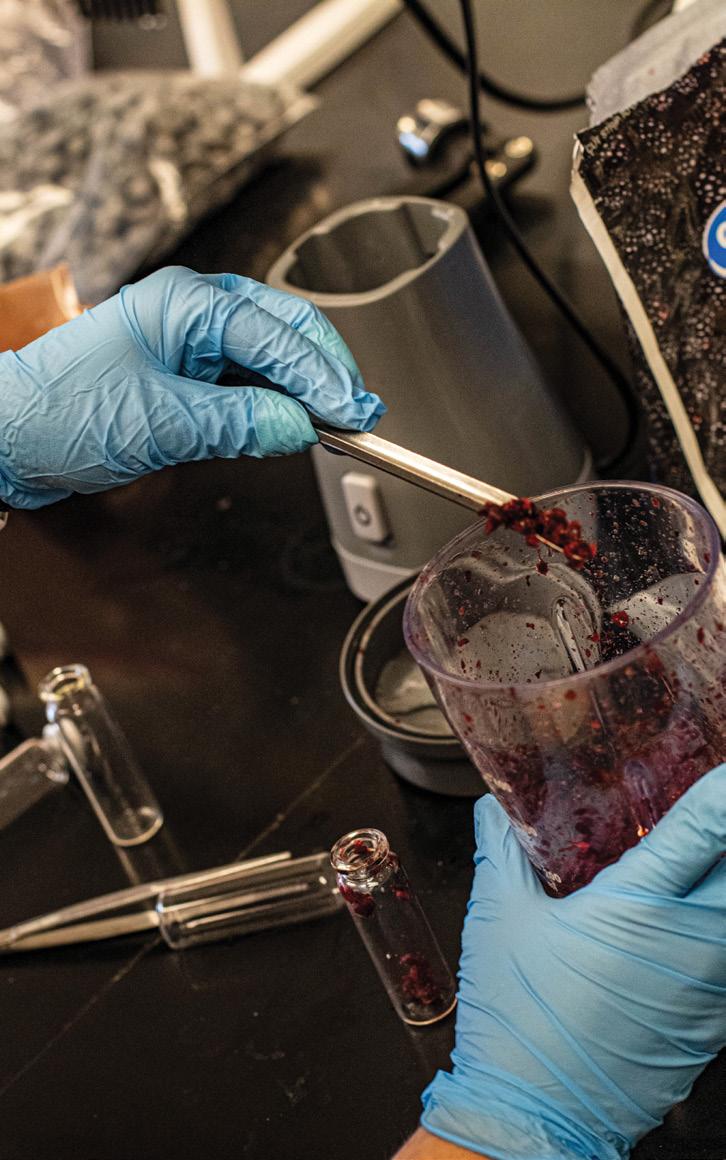
4 minute read
Tayloring a Tangle
OSU graduate student dedicates research to uncover the correlatrion between four major agricultural impacts
Meat discoloration, greenhouse gas emissions, agriculture economics and consumer preferences. These four things may seem unrelated, but to Taylor Price, an Oklahoma State University food science graduate student, they are tangled together in a powerful web.
Advertisement
According to the Food and Agriculture Organization of the United Nations, the population of the world is set to increase by 2.3 billion by the year 2050.
In other words, more people, less resources and an increased demand for food.
“My current research concerns sustainability and economic loss in the beef industry,” Price said. “I love getting to apply my skills and interest to help solve real world problems and impact the agricultural industry.”

Price's research stems from a project 16 years in the making. Ranjith Ramanathan and Jason Warren, OSU faculty, met by chance at a meeting where they discussed their respective research. Ramanathan's research focuses on the factors affecting meat discoloration and how to reduce meat loss while Warren's research expertise involves greenhouse gas quantification.
The driving force behind Price's desire to begin this project was the aspect of sustainability, she said. Sustainability is how agriculturalists will complete the task and goal that is 2050, she added.
“The goal of my research is to calculate greenhouse gas emissions for wasted food products,” Price said.
According to the Inventory of United States Greenhouse Emissions and Sinks, the U.S. emitted 6.5 billion metric tons of greenhouse gases in 2017 alone.
Greenhouse gas emissions are believed to impact climate change, Price said. Climate change has become a major topic in the agricultural industry, she added.
“The changing climate affects society and ecosystems in a variety of ways,” according to the U.S. Environmental Protection Agency.
The EPA lists multiple possible impacts of climate change including risk of heat-related illnesses, increased air pollution, increased heat waves, droughts and floods that may reduce crop yields, increased sea levels that could erode coastal ecosystems and eliminate wetlands, and the alteration of were species live and interact that could change entire ecosystems.
“This research is not focused on taking a climate change stance,” Price said. “The focus is to provide information and statistics to be used for future research projects.”
Price is researching greenhouse emissions across meat animal proteins and fruit/vegetable combinations. Using a gas chromatography machine in Warren's research lab, she is able to measure the emissions put off by the waste of these products.
“Since my research has just begun, I am using different combinations to establish a base,” Price said.
According to information from the University of Colorado Boulder, gas chromatography allowes gases to be broken into pure components and then measured accordingly.
With these numbers, Price plans to decipher the amount of greenhouse emissions correlating with food waste in landfills.
According to the United States Department of Agriculture, in 2010, food loss and waste at the retail and consumer levels equaled 113 pounds, or 31 percent, of the food supply. Financially, this is equivalent to almost $162 billion.

“For the economic loss, we are trying to compile numbers and formulas from agriculture economists,” Price said.
The research is set to use the numbers and formulas to determine how much discolored beef attributes to economic loses in the beef industry, Price said. Plus, using this data can help determine how much discolored beef adds to the food waste total, she added.
Information provided by the USDA Food Safety and Inspection Service states, “When meat is fresh and protected from contact with air, it has the purple-red color that comes from myoglobin, one of the two key pigments responsible for the color of meat. When exposed to air, myoglobin forms the pigment, oxymyoglobin, which gives meat a pleasingly cherryred color.”
According to the USDA FSIS, light exposure and contact of myoglobin and oxymyoglobin to oxygen leads to the formation of metmyoglobin, a pigment that turns meat brownish-red.
This color change alone doesn't mean the meat has spoiled, but it can affect the way consumers perceive the product.
Discolored beef is safe to consume, the metmyoglobin pigment is not dangerous, Price said. Consumers throw away discolored beef because they believe it is spoiled, she added.
Price is focusing on discolored beef because color is a major factor for consumers when looking to purchase meat products.
When people throw out discolored beef that is not spoiled, they add to the amount of food waste in landfills, Price said. Then, the waste emits greenhouse gases as it decomposes, she added.
As part of the research experiment, Price plans to evaluate consumer preferences of discolored beef.
“The consumer acceptability will be tested next fall, during football season,” Price said. “I can target consumers in a heavily populated and well-trafficked area while establishing a benchmark for consumer acceptability and price in discolored beef.”
The data gained in this research can be used to change consumer acceptability of beef discoloration, Price said. It will help agriculturalists educate consumers, who are prone to throwing away product before it spoils, about beef discoloration, she added.
“This research is important because we have not updated the number for economic loss of discoloration in the beef industry for 20 years,” Price said.
This research can be used to supply the beef industry with updated numbers on discolored beef and how much the industry uses each year, Price said. Moreover, it will help agriculturalists understand the impact of food waste on the gas emissions coming from landfills, she added.
“I am hoping to add information,” Price said. “To get a more complete understanding behind consumer preference, the chemistry behind it, and even the gases that can be produced from wasted food products.”
STORY BY BRAEDEN COON






